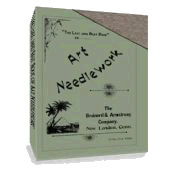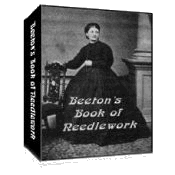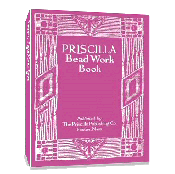1898 Popular Doilies
Edited by M. Schlueter for use on this site
In 1898 popular doilies included Russian Embroidery doilies, doilies with rose designs, and lacy doilies were all the rage. The following information was published in 1898 in Harper’s Bazaar. Maybe you’ll be encouraged to make your own using one of the following three methods. Whichever one you would try is sure to be beautiful.

Every notable housekeeper takes a pride in her linen-closet, an as there were never greater opportunities than now for buying beautiful linen, the linen-closets are really most attractive, neatly arranged, wit the different kinds of linen tied up with bright ribbon, each in its respective pile, and with the scent of lavender faintly pervading all. On sheets the needle-work shows in the hem-stitching and the initials or monogram, while on pillow-slips there is often, besides the he-stitching and monogram, a narrow vine of embroidery.
Table-linen affords a peculiarly inviting field for dainty needle-work; some of it is simply exquisite. The finest table-cloths are hem-stitched and embroidered, as are the napkins, and there are a great many new designs in the lettering, and even in the hem-stitching; the drawn-work too comes under this head, and it means be remembered that this can be used for both bed and table linens, and there are many beautiful designs for bedspreads with pillow-cases to match.
It is a fashion of the hour to use, whenever possible, a bare dining-table, and this affords great scope for center-pieces, napkins placed under plates, and doilies to match. There are a great many different designs and shapes to use, and it is surprising how many different materials come into play. All, however, must be of the finest, and the work must be of the best quality, for every stitch will show.
When damask napkins and center pieces are used, hem-stitching only is permitted; but with the plain linen come into play drawn-work, and even embroidery in the wash silks. Jus now it is said to be fashionable to have everything on the table white, and no color admitted except in the flowers used in decoration, consequently there is any amount of lace-work and drawn-work to be seen.
The shops are flooded with machine-made centre-pieces with plain linen centers and heavy lace edges, made generally of cotton braid; but there is absolutely nothing where real and imitation lace show in stronger contrast. Among the most beautiful pieces of work at the Decorative Art Society are doilies made with a fine linen centre, round in shape, and trimmed with a lace border of the finest braid, that is all made by hand. The lace is rather lighter in effect than has ordinarily been seen, and the work is of the finest.
These doilies are very small, and should be used on dessert-plates. They may be lined with a color, if so desired, but the idea is to use them just as they are, and they look particularly well on the solid-colored plates that are so much in fashion. They also look well on the glass plates, and, when used with a centre-piece to match on the bare table, are sometimes put directly on the table, and of course, if it happens to be a mahogany table, the design stands out very clearly.
Popular Doily #1

Click on picture to see more detail.
A very fashionable style of doily is a fine square and made of much heavier linen. It is in the Russian Style, and is done in button-hole stitch with insertion of drawn-work. It is a difficult kind of work, and of necessity expensive, for it takes time to execute it properly; but it is a charming sort of fancy-work, and is, besides, most useful, as it washes and wears well.
These doilies are made very small, in square of irregular edges, the edges heavily embroidered, and are rarely, if ever, round in shape. The square irregular edge seems most suitable to the design.
Popular Doily #2

Click on picture to see more detail.
In the colored doilies there is a wide range of choice, and the coloring of many is exquisite. Some are made on heavy linen, embroidered in wash silk to match a centre-piece, but the daintiest of all are those which are used quite irrespective of the centre-piece, and which, like rare sets of plates, are always correct. The handsomest of these are made on the very sheer linen, and are embroidered in very faint shades of silk to represent roses, poppies, or any one of the large flowers. The one that is illustrated represents a rose, and is done in the palest pink and light green silks. There is a little lace-work let into this doily, which makes it more than ever sheer and transparent, and some designs look almost as though they were the petals of the flowers they represent.
Occasionally the designs are worked in the darker shades of silk, but when this is done they rather lose their distinctive features of delicate coloring. They are always small and are suitable only to be used for dessert, but they certainly make a great addition in the attractive appearance of a dinner table.
For constant every-day use there are many little doilies made of a square of sheer linen with an elaborate hem-stitching, and embroidered with a design of small flowers done in outline. For instance, one doily will have forget-me-nots, another buttercups, another wild roses, and still another daisies. These, if made of the wash silks, launder well, and are very useful and at the same time ornamental. There is very little work on them, but this ought to be well done, and the linen should be of the finest quality.
Popular Doily #3

Click on picture to see more detail.
The Mexican and Fayal work is still very fashionable in doilies, and some of it is most beautiful. It is very fine drawn-work, and the patterns are many and various. It is rarely seen on any but the smallest sized doilies, and looks like lace-work. It is very transparent, but lacks a certain something that the hand-embroidered handsomer doilies posses. Perhaps it is because this work has been very much imitated on the machine, while as yet no machine-work compares favorably with the work already described, either in all white lace and drawn-work or in the silk embroidered; for although the latter has of course been extensively copied, and with great success, it by no means requires an expert to tell the difference.
Return to top of 1898 Popular Doilies page.
Return to Victorian Crafts page.
Return to Home page.



 433 pages!
433 pages!

